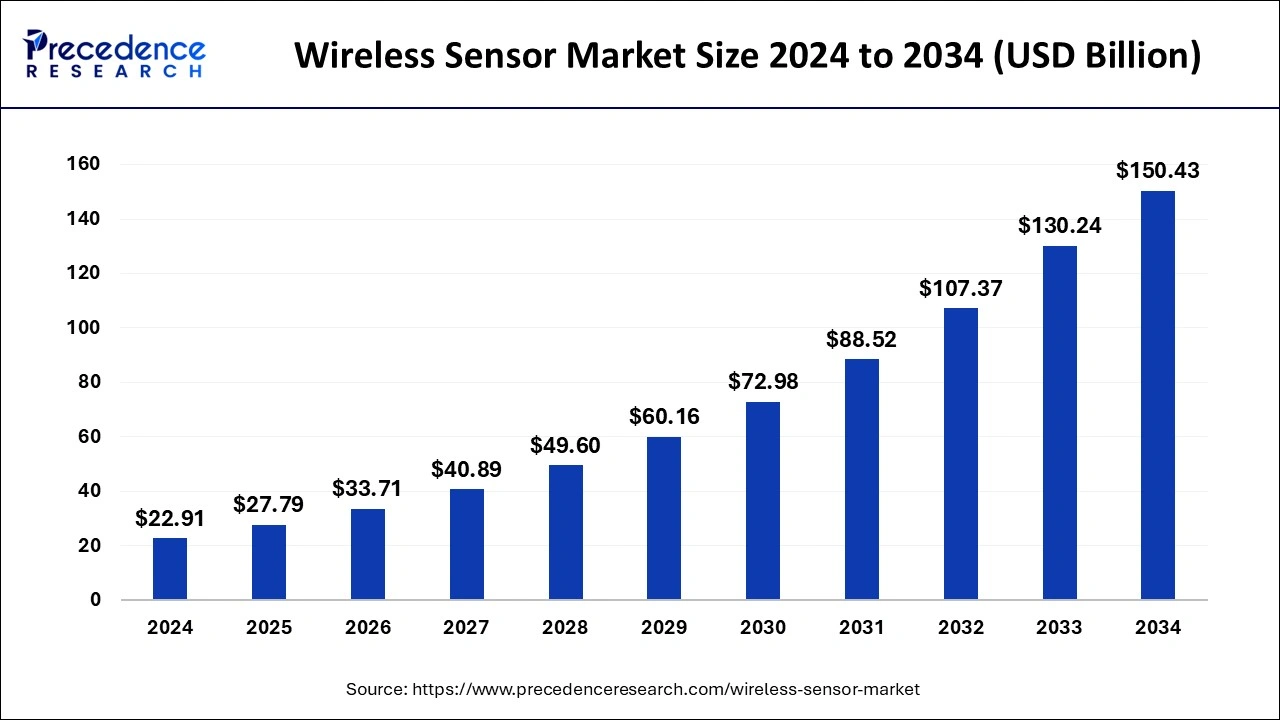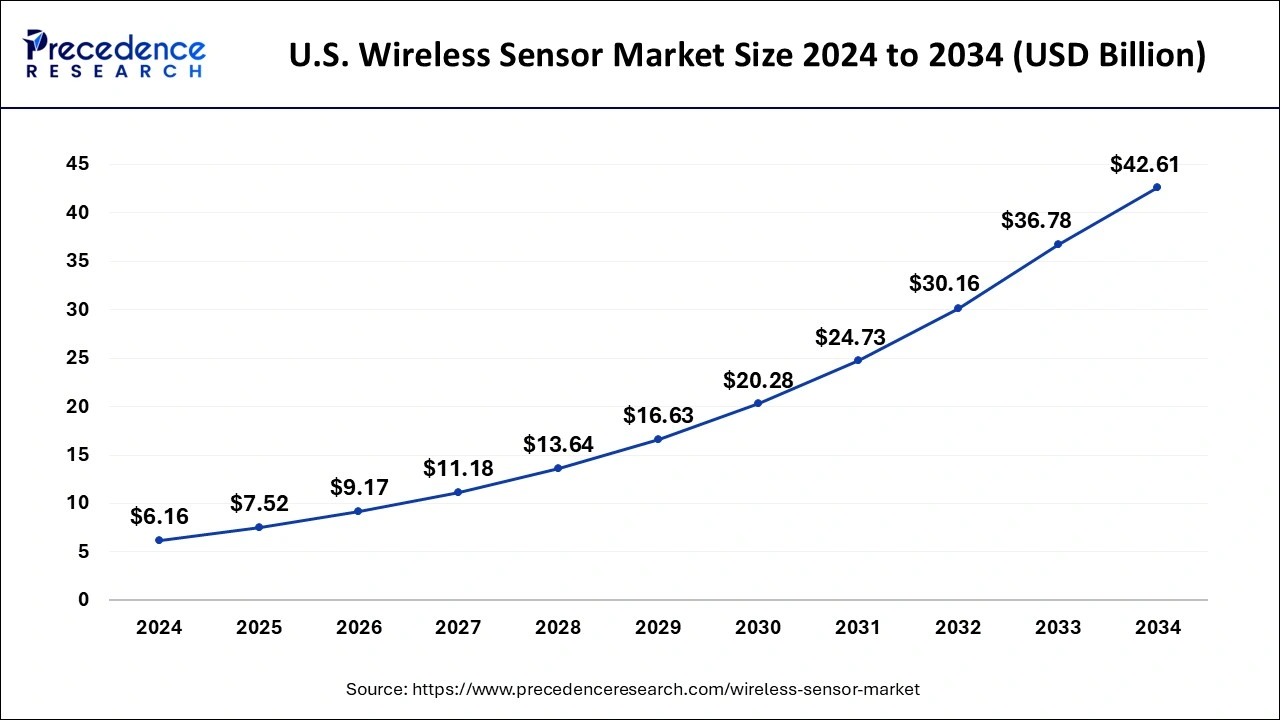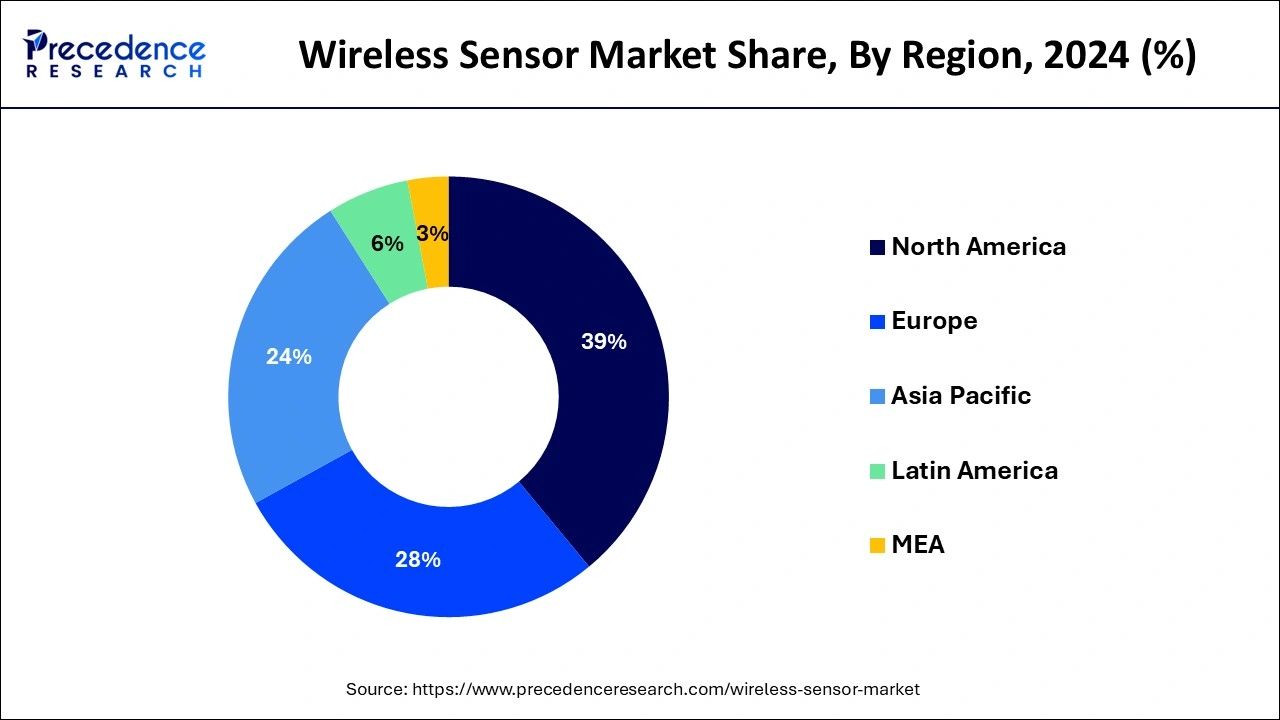Wireless Sensor Market Size and Forecast 2025 to 2034
The global wireless sensor market size was calculated at USD 22.91 billion in 2024 and is predicted to increase from USD 27.79 billion in 2025 to approximately USD 150.43 billion by 2034, expanding at a CAGR of 20.71% from 2025 to 2034.

Wireless Sensor Market Key Takeaways
- The global wireless sensor market was valued at USD 22.91 billion in 2024.
- It is projected to reach USD 150.43 billion by 2034.
- The wireless sensor market is expected to grow at a CAGR of 20.71% from 2025 to 2034.
- North America contributed more than 39% of revenue share in 2024.
- Asia Pacific is estimated to expand the fastest CAGR between 2025 and 2034.
- By product type, the biosensors segment has held the largest market share of 21% in 2024.
- By product type, the level sensors segment is anticipated to grow at a remarkable CAGR of 24.5% between 2025 and 2034.
- By industry vertical, the consumer electronics segment generated over 24% of revenue share in 2024.
- By industry vertical, the agriculture segment is expected to expand at the fastest CAGR over the projected period.
U.S. Wireless Sensor Market Size and Growth 2025 to 2034
The U.S. wireless sensor market size was evaluated at USD 6.16 billion in 2024 and is projected to be worth around USD 42.61 billion by 2034, growing at a CAGR of 21.34% from 2025 to 2034.

North America has held the largest revenue share 39% in 2024. North America holds a significant share in the wirelesssensors market due to a robust technological infrastructure, widespread adoption of IoT applications, and a high degree of industrial automation. The region's early and sustained investments in research and development, coupled with a strong presence of key market players, contribute to its leadership. Additionally, the demand for wireless sensors in diverse sectors such as healthcare, agriculture, and manufacturing, further fuels North America's dominance in this market.
Asia-Pacific is estimated to witness the highest growth. Asia-Pacific commands a significant share of the wireless sensors market due to rapid industrialization, technological advancements, and the proliferation of IoT applications across diverse sectors. Growing demand for smart infrastructure, manufacturing automation, and the deployment of wireless sensors in emerging economies such as China and India contribute to the region's dominance. Additionally, government initiatives promoting digitalization and the adoption of Industry 4.0 technologies further fuel the expansion of the wireless sensor market in the Asia-Pacific region.

Market Overview
Wireless sensors represent compact electronic devices engineered to measure and relay data without the encumbrance of physical connections or wiring. Leveraging technologies such as Wi-Fi, Bluetooth, Zigbee, or cellular networks, these sensors communicate information seamlessly to a central system or other interconnected devices. Their applications span diverse sectors including manufacturing, healthcare, environmental monitoring, and smart home systems.
The distinctive advantage of wireless sensors lies in their capacity to furnish real-time data unburdened by the constraints of traditional wired setups. This adaptability facilitates deployment in unconventional or challenging locations where wired alternatives may be impractical, ensuring comprehensive and dynamic monitoring capabilities. Furthermore, wireless sensor networks offer scalability, enabling the integration of a multitude of sensors to form expansive networks that significantly enhance the efficiency of data collection and analytical processes. Serving as a foundational element within the Internet of Things (IoT), wireless sensors play an indispensable role in propelling automation, refining decision-making processes, and augmenting overall connectivity within the contemporary technological landscape.
Wireless Sensor Market Growth Factors
- Rising demand for industrial automation: Increased adoption of wireless sensors in industrial settings to enhance efficiency and automation processes.
- IoT integration: Growing applications in the Internet of Things (IoT) ecosystem, driving demand for connected devices and smart systems.
- Advancements in communication technologies: Ongoing developments in communication protocols like 5G, enhancing data transfer capabilities of wireless sensors.
- Miniaturization and energy efficiency: Continuous efforts to make sensors smaller and more energy-efficient, expanding their use in various applications.
- Surge in healthcare applications: Wireless sensors playing a pivotal role in healthcare for remote patient monitoring and data collection.
- Environmental monitoring needs: Increasing focus on environmental conservation, leading to a rise in demand for sensors in monitoring air and water quality.
- Smart home integration: Growing trend of smart homes and smart cities, boosting the demand for sensors in home automation systems.
- Precision agriculture adoption: Wireless sensors employed in precision agriculture for real-time monitoring of soil conditions and crop health.
- Demand for wearable devices: Integration of sensors in wearable technology for fitness tracking, health monitoring, and overall well-being.
- Military and defense applications: Growing use of sensors for surveillance, reconnaissance, and monitoring in military and defense operations.
- Smart grid implementation: Wireless sensors contributing to the development of smart grids for efficient energy management.
- Supply chain optimization: Adoption of sensors for real-time tracking and monitoring in supply chain management, improving logistics efficiency.
- Increasing urbanization: Rise in urban development projects, fueling the need for sensor-based technologies in smart city initiatives.
- Enhanced data analytics: Growing emphasis on data-driven decision-making, with wireless sensors providing valuable data for analysis.
- Development of autonomous vehicles: Integration of sensors in autonomous vehicles for navigation, obstacle detection, and safety features.
- Remote infrastructure monitoring: Use of sensors for remote monitoring of critical infrastructure, such as bridges and pipelines.
- Emergence of edge computing: Wireless sensors supporting edge computing for faster data processing and reduced latency.
- Technological convergence: Convergence of technologies like Artificial Intelligence (AI) with wireless sensors, enhancing their capabilities.
- Increased research and development: Ongoing R&D efforts leading to the innovation of new sensor technologies and functionalities.
- Regulatory support: Supportive regulations promoting the use of wireless sensors in various industries, fostering market growth.
Market Scope
| Report Coverage | Details |
| Growth Rate from 2025 to 2034 | CAGR of 20.71% |
| Market Size in 2025 | USD 27.79 Billion |
| Market Size in 2024 | USD 22.91 Billion |
| Market Size by 2034 | USD 150.43 Billion |
| Largest Market | North America |
| Base Year | 2024 |
| Forecast Period | 2025 to 2034 |
| Segments Covered | Product Type and Industry Vertical |
| Regions Covered | North America, Europe, Asia-Pacific, Latin America, and Middle East & Africa |
Market Dynamics
Driver
Industry 4.0 adoption and IoT proliferation
The adoption of Industry 4.0 principles, emphasizing the integration of digital technologies into manufacturing processes, significantly surges the demand for wireless sensors. Industry 4.0 relies on real-time data collection, analysis, and communication between machines, enabling intelligent decision-making and process optimization. Wireless sensors play a pivotal role in this transformation, facilitating seamless connectivity and data exchange across the manufacturing ecosystem. Their ability to monitor equipment health, track production parameters, and enable predictive maintenance aligns perfectly with the objectives of Industry 4.0, driving the market demand.
Simultaneously, the proliferation of the Internet of Things (IoT) amplifies the need for wireless sensors across diverse sectors. As IoT continues to expand, connecting an ever-growing number of devices, sensors become essential components in this interconnected landscape. Wireless sensors enable the transmission of data from IoT devices to centralized systems, supporting applications ranging from smart homes and cities to healthcare and agriculture. The synergy between Industry 4.0 and IoT creates a compelling narrative, propelling the demand for wireless sensors as critical enablers of smart, data-driven, and efficient processes across industries.
Restraint
Security concerns and security concerns
Security concerns pose a significant restraint on the market demand for wireless sensors, creating apprehension among potential users. As these sensors play a crucial role in collecting and transmitting sensitive data, the risk of unauthorized access and cyber threats becomes a primary deterrent. Industries and organizations are cautious about the potential compromise of critical information, leading to a reluctance to adopt wireless sensor technologies. The fear of security breaches not only impacts the confidence of end-users but also hampers regulatory compliance efforts, especially in sectors with stringent data protection requirements.
Concerns over data integrity, confidentiality, and the potential for system vulnerabilities contribute to a hesitancy to invest in wireless sensor solutions. Addressing these security challenges through robust encryption, authentication mechanisms, and continuous advancements in cybersecurity practices is essential to alleviate these concerns and foster greater market acceptance of wireless sensor technologies.
Opportunity
Expansion of smart cities and healthcare innovation
The expansion of smart cities represents a significant opportunity for the wireless sensor market. In smart city initiatives, wireless sensors play a crucial role in urban planning, traffic management, and environmental monitoring. These sensors enable the collection of real-time data, contributing to efficient city services and sustainability efforts. As cities worldwide strive to become more technologically advanced and interconnected, the demand for wireless sensors is set to rise, presenting lucrative opportunities for companies in the market.
In the healthcare sector, innovation driven by wireless sensors opens up new possibilities for remote patient monitoring, telehealth, and improved medical diagnostics. These sensors, when integrated into medical devices, offer precise and timely health data, contributing to personalized and effective patient care. As the healthcare landscape continues to evolve towards more technologically advanced and patient-friendly practices, wireless sensors are positioned as essential components, presenting promising prospects for market growth and development.
Product Type Insights
In 2023, the biosensors segment held the highest market share of 21% on the basis of the product type. The biosensors segment in the wireless sensors market involves devices that detect biological responses and convert them into measurable signals. These sensors find application in healthcare, environmental monitoring, and food safety. Trends in biosensors include the integration of nanotechnology for enhanced sensitivity, the rise of wearable biosensors for continuous health monitoring, and the development of point-of-care biosensors for rapid and decentralized testing. With increasing focus on personalized medicine and advancements in biotechnology, the biosensors segment is poised for growth in various industries due to its versatile and precise detection capabilities.
The level sensors segment is anticipated to witness the highest growth at a significant CAGR of 24.5% during the projected period. The level sensors segment in the wireless sensor market involves devices that measure the level of liquids or solids in containers. These sensors play a crucial role in industries like manufacturing, oil and gas, and water management.
A notable trend in this segment is the increasing adoption of non-contact level sensors, utilizing technologies like ultrasonic and radar, which offer higher accuracy and reliability. As industries prioritize automation and efficiency, the demand for advanced level sensors is expected to continue growing, driving innovation and expanding applications across diverse sectors.
Industry Vertical Insights
According to the industry vertical, the consumer electronics segment has held a 24% revenue share in 2023. The consumer electronics segment in the wireless sensors market refers to the integration of sensors into everyday devices, enhancing functionality and user experience. In this vertical, wireless sensor are increasingly embedded in smartphones, smartwatches, and other gadgets. Current trends include the incorporation of sensors for health monitoring in wearables, improved gesture recognition in gaming consoles, and enhanced environmental sensors in smartphones.
The consumer electronics sector continues to drive innovation, demanding smaller, more energy-efficient sensors to support the development of smart and interconnected devices for everyday use.
The agriculture segment is anticipated to witness the highest growth over the projected period. In the wireless sensors market's agriculture segment, sensors are employed for precision farming, monitoring soil conditions, crop health, and environmental factors. This technology allows farmers to make data-driven decisions, optimizing resource usage and improving overall agricultural efficiency. Trends in this segment include the integration of wireless sensors in irrigation systems, the use of drones equipped with sensors for aerial monitoring, and the development of smart farming applications that leverage real-time data to enhance crop yield and sustainability in modern agriculture practices.
Wireless Sensor Market Companies
- Honeywell International Inc.
- STMicroelectronics
- TE Connectivity Ltd.
- Siemens AG
- Texas Instruments Incorporated
- Emerson Electric Co.
- ABB Ltd.
- Bosch Sensortec
- NXP Semiconductors
- Schneider Electric SE
- General Electric Company
- Analog Devices, Inc.
- Infineon Technologies AG
- IBM Corporation
- Sensirion AG
Recent Developments
- In 2022, Honeywell introduced an innovative sustainability solution focused on carbon emissions monitoring and optimization, successfully deployed in its own facilities. Utilizing the Honeywell Versatilis™ Signal Scout™ wireless Industrial IoT leak detection sensors, the system allows organizations to monitor emissions in near real-time, aiding industrial sectors in achieving greenhouse gas reduction targets.
- STMicroelectronics, a prominent semiconductor leader, unveiled its third-generation MEMS sensors in February 2022, delivering enhanced performance for consumer mobiles, smart industries, healthcare, and retail. In a collaborative effort with Metalenz Inc. in June 2021, STMicroelectronics embarked on a co-development and license agreement to advance Metalenz's meta-optics technology for smartphones, consumer devices, healthcare, and automotive applications.
- In March 2020, TE Connectivity successfully completed the public takeover of First Sensor AG, a global player in sensor technology with expertise in chip design and production. First Sensor specializes in developing standard and custom sensor solutions for industrial, medical, and transportation applications.
- Furthermore, in May 2021, Honeywell expanded its portfolio with the development of two robust Inertial Measurement Units (IMU) designed for military and rugged industrial environments. The HG1125 and HG1126 sensors are engineered to withstand extreme shocks, making them suitable for applications with harsh impact scenarios such as ballistics tests.
Segments Covered in the Report
By Product Type
- Biosensors
- Temperature Sensor
- Pressure Sensor
- Humidity Sensors
- Gas Sensors
- Flow Sensors
- Level Sensors
- Motion and Positioning Sensors
- Others
By Industry Vertical
- Consumer Electronics
- Industrial
- Automotive and Transportation
- Aerospace and Defense
- Healthcare
- Agriculture
- Others
By Geography
- North America
- Europe
- Asia-Pacific
- Latin America
- Middle East and Africa
For inquiries regarding discounts, bulk purchases, or customization requests, please contact us at sales@precedenceresearch.com
Frequently Asked Questions
Ask For Sample
No cookie-cutter, only authentic analysis – take the 1st step to become a Precedence Research client
 sales@precedenceresearch.com
sales@precedenceresearch.com
 +1 804-441-9344
+1 804-441-9344